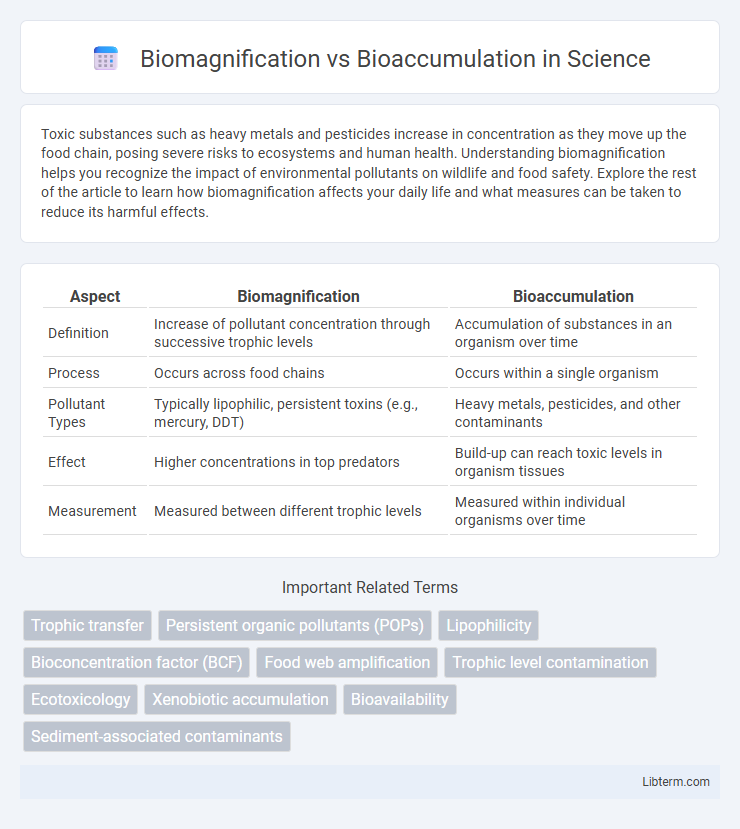Toxic substances such as heavy metals and pesticides increase in concentration as they move up the food chain, posing severe risks to ecosystems and human health. Understanding biomagnification helps you recognize the impact of environmental pollutants on wildlife and food safety. Explore the rest of the article to learn how biomagnification affects your daily life and what measures can be taken to reduce its harmful effects.
Table of Comparison
| Aspect | Biomagnification | Bioaccumulation |
|---|---|---|
| Definition | Increase of pollutant concentration through successive trophic levels | Accumulation of substances in an organism over time |
| Process | Occurs across food chains | Occurs within a single organism |
| Pollutant Types | Typically lipophilic, persistent toxins (e.g., mercury, DDT) | Heavy metals, pesticides, and other contaminants |
| Effect | Higher concentrations in top predators | Build-up can reach toxic levels in organism tissues |
| Measurement | Measured between different trophic levels | Measured within individual organisms over time |
Introduction to Biomagnification and Bioaccumulation
Biomagnification refers to the increasing concentration of toxic substances like mercury or DDT in the tissues of organisms at each successive level of the food chain. Bioaccumulation describes the gradual accumulation of contaminants in an individual organism's body over time, often occurring when the intake rate exceeds the elimination rate. Understanding biomagnification and bioaccumulation is essential for assessing the environmental impact of pollutants and their potential risks to wildlife and human health.
Defining Biomagnification
Biomagnification refers to the increasing concentration of toxic substances, such as heavy metals or pesticides, as they move up through the trophic levels of a food chain. This process results in higher toxin levels in predators at the top of the food chain compared to organisms at lower levels. Unlike bioaccumulation, which occurs within a single organism over time, biomagnification involves the amplification of contaminants across multiple organisms and ecological levels.
Defining Bioaccumulation
Bioaccumulation refers to the gradual accumulation of toxic substances, such as heavy metals or pesticides, within an organism over time. This process occurs when the rate of intake exceeds the organism's ability to eliminate the toxins, leading to higher internal concentrations than those found in the environment. Unlike biomagnification, which describes toxin concentration increase through food chains, bioaccumulation focuses on the buildup of toxins in a single organism.
Key Differences Between Biomagnification and Bioaccumulation
Biomagnification refers to the increasing concentration of toxic substances, such as mercury or DDT, as they move up the food chain, resulting in higher levels in apex predators. Bioaccumulation occurs when organisms absorb contaminants directly from their environment or through food, leading to a gradual buildup within their tissues over time. The key difference lies in biomagnification's amplification across trophic levels, whereas bioaccumulation focuses on pollutant accumulation within a single organism.
Mechanisms of Biomagnification
Biomagnification occurs when toxic substances increase in concentration as they move up the food chain, primarily due to the consumption of contaminated organisms. The mechanism involves the persistent accumulation of pollutants like heavy metals or persistent organic pollutants (POPs) in higher trophic levels, where these toxins are absorbed faster than they are excreted. This process differs from bioaccumulation, which refers to the buildup of toxins within a single organism over time, rather than through the transfer across multiple levels of the ecosystem.
Mechanisms of Bioaccumulation
Bioaccumulation occurs when organisms absorb toxic substances faster than their bodies can eliminate them, leading to increasing concentrations over time. This process primarily involves direct absorption from the environment, dietary intake, and retention in tissues due to the chemical's persistence and lipophilicity. Unlike biomagnification, which amplifies toxin levels across trophic levels, bioaccumulation focuses on the buildup within individual organisms through prolonged exposure.
Common Pollutants Involved
Common pollutants involved in biomagnification and bioaccumulation include heavy metals such as mercury and lead, persistent organic pollutants (POPs) like DDT and PCBs, and certain pesticides that resist environmental degradation. These toxic substances accumulate in organisms over time (bioaccumulation) and increase in concentration as they move up the food chain (biomagnification), leading to harmful effects on wildlife and humans. Monitoring pollutant levels in aquatic ecosystems is critical for managing risks associated with these compounds.
Environmental and Health Impacts
Biomagnification increases toxin concentrations as contaminants move up the food chain, leading to severe health risks like reproductive disorders and neurological damage in apex predators, including humans. Bioaccumulation causes persistent chemical buildup in individual organisms, impairing immune function and growth, while disrupting ecosystems by altering species survival and biodiversity. Both processes amplify environmental pollution effects, threatening aquatic and terrestrial habitats through toxic substance retention and transfer.
Examples in Real-world Ecosystems
Biomagnification occurs when mercury concentrations increase from plankton to larger predatory fish such as tuna and swordfish, impacting species higher in the food chain and humans consuming seafood. Bioaccumulation is evident in organisms like freshwater mussels accumulating heavy metals like cadmium from sediments over time without transfer between trophic levels. These processes demonstrate how toxic substances like PCBs and DDT concentrate within ecosystems, threatening biodiversity in aquatic webs such as the Great Lakes and Amazon River basin.
Prevention and Mitigation Strategies
Preventing biomagnification and bioaccumulation requires reducing the release of persistent organic pollutants (POPs) and heavy metals into ecosystems through stricter industrial regulations and wastewater treatment improvements. Implementing habitat restoration and promoting sustainable agricultural practices minimize toxin entry into food chains, thereby mitigating risks to wildlife and human health. Regular monitoring of contaminant levels in key species supports early detection and effective management of toxic accumulation.
Biomagnification Infographic

 libterm.com
libterm.com